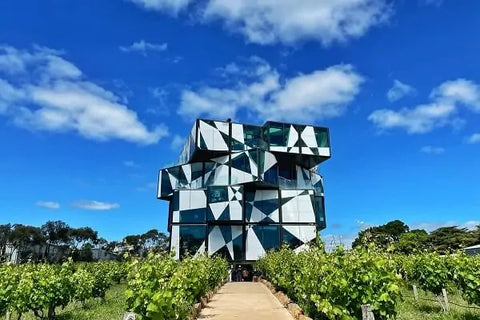Discovering the Diverse Terroir of McLaren Vale: A Geological Wonderland
McLaren Vale has rightfully earned its place among the world's most geologically diverse wine regions. Just 40 minutes south of Adelaide, this coastal wine paradise boasts an extraordinary tapestry of soil types and geological formations that translate directly into the distinctive character and complexity of its wines.
A Geological Treasure Trove
What makes McLaren Vale truly exceptional is its remarkable geological diversity—over 55 unique geological formations packed into one wine region, ranging in age from a youthful 15,000 years to an astounding 550+ million years old. This diversity isn't just interesting for geologists; it's a fundamental element that shapes the distinctive character of McLaren Vale wines.
The region's geological story was officially documented in 2010 through the "Geology of McLaren Vale Wine Region" map, developed after decades of research by geologists Bill Fairburn, Jeff Olliver, Wolfgang Preiss, and wine writer Philip White. This groundbreaking map (updated in 2019) continues to guide viticulturists in making planting decisions and helps wine lovers understand the deep connection between geology and flavour.
The Major Terroir Types of McLaren Vale
Blewitt Springs: Sandy Elegance
Located in the northern reaches of McLaren Vale at higher elevations (around 200m), Blewitt Springs is characterised by deep, well-drained sandy soils over clay. This area receives slightly higher rainfall and experiences cooler temperatures than other parts of the region.
Wine characteristics: Wines from Blewitt Springs, particularly Grenache and Shiraz, typically display remarkable elegance, perfumed aromatics, bright red fruit notes, and a distinctive mineral freshness. The sandy soils encourage deep root systems, resulting in complex wines with finer tannins and vibrant acidity.
Seaview: Hillside Complexity
Situated on the elevated slopes where the Mount Lofty Ranges meet the plains, Seaview features some of the region's most varied terrain. Its soils range from shallow red-brown earth over limestone and ironstone to clay loams, all with excellent drainage due to the sloping aspect.
Wine characteristics: The elevation and exposure create more concentrated wines with firm tannin structures. Shiraz from this area tends to be full-bodied with intense dark fruit flavours, chocolate notes, and distinctive spice elements.
McLaren Flat: Rich Expression
Found in the central eastern part of the region, McLaren Flat features a complex mix of sandy, well-drained soils over clay and gravel substrates. This area sits in a slight depression, sheltered by the surrounding hills.
Wine characteristics: Wines from McLaren Flat, particularly Shiraz and Cabernet Sauvignon, showcase rich, plush fruit character with generous mid-palate weight and velvet-like tannins. The sheltered aspect helps develop fully ripened fruit characters while retaining essential acid balance.
Willunga: Ancient Foundations
Situated against the dramatic backdrop of the Willunga Fault escarpment, this subregion features some of McLaren Vale's oldest geological formations. Soils here often include red-brown earth with significant limestone influence and clay-loam mixtures.
Wine characteristics: Wines from Willunga display remarkable structural complexity and aging potential. Shiraz from this area typically shows blackberry and plum characteristics with a structured mineral backbone and savoury notes.
Sellicks: Coastal Influences
Located in the southern reaches of McLaren Vale, closest to the coast, Sellicks features calcareous soils (high in limestone) with significant ancient rock influences. The cooling maritime effect is strongest here.
Wine characteristics: Wines from this area tend to show pronounced mineral characteristics with taut structure and bright acidity. Shiraz from Sellicks often displays blueberry notes, floral elements, and a distinctive saline character reflecting the maritime influence.
The Geological Formations Shaping McLaren Vale
The region's wines are influenced by several major geological groupings:
Ancient Rocks (500-800 million years old)
Part of the Adelaide Geosyncline, these are some of Australia's oldest rock formations. They form the foundation of the region and contribute to the distinctive minerality in many McLaren Vale wines, particularly those from vineyards planted in the foothills.
Maslin Sands
Deposited roughly 50 million years ago as the sea advanced over the land, these sandy formations (North and South Maslin Sands) host some of McLaren Vale's oldest and most prized vineyards. The well-drained sandy soils with excellent water-holding capacity often allow for dry-farming, resulting in concentrated, character-filled wines.
Blanche Point Formation
Consisting of sand, silt, clay, and limestone deposited approximately 35 million years ago when Australia separated from Antarctica, this formation contributes to the elegance and structural complexity of wines from these sites.
Pirramimma Sandstone
A distinctive buff-colored sandstone formation stretching from south of McLaren Vale to northeast of McLaren Flat, this relatively younger geological feature produces wines with distinctive textural qualities and aromatic expression.
How Terroir Translates to Your Glass
When you taste a McLaren Vale wine, you're experiencing the direct influence of this geological diversity:
- Shiraz, the region's signature variety, displays remarkable variation across different terroirs—from the powerful, chocolatey expressions of Seaview to the perfumed, more elegant styles from Blewitt Springs.
- Grenache perhaps demonstrates terroir influence most dramatically, with sandy Blewitt Springs sites producing ethereal, aromatic wines, while heavier soils produce more structured, robust expressions.
- Cabernet Sauvignon shows excellent regional distinction, with limestone-influenced sites producing wines with exceptional aging potential and structured tannins.
- Mediterranean varieties like Fiano, Vermentino, Tempranillo, and Sangiovese thrive in McLaren Vale's diverse terroirs, each finding its perfect match among the region's varied soil types.
A Living Laboratory
McLaren Vale stands at the forefront of terroir research in Australia. The region's comprehensive geological mapping continues to guide sustainable vineyard practices and inspire a new generation of site-specific wines that truly capture the essence of place.
This geological diversity isn't just an academic curiosity—it's the foundation of McLaren Vale's identity as a wine region. By understanding these varied terroirs, wine lovers can better appreciate the distinctive character of McLaren Vale wines and the remarkable landscape that shapes them.
Next time you open a bottle from McLaren Vale, take a moment to consider the ancient geological forces that helped shape what's in your glass—the result of millions of years of Earth's history expressed through the art of winemaking.




Comments (0)
There are no comments for this article. Be the first one to leave a message!